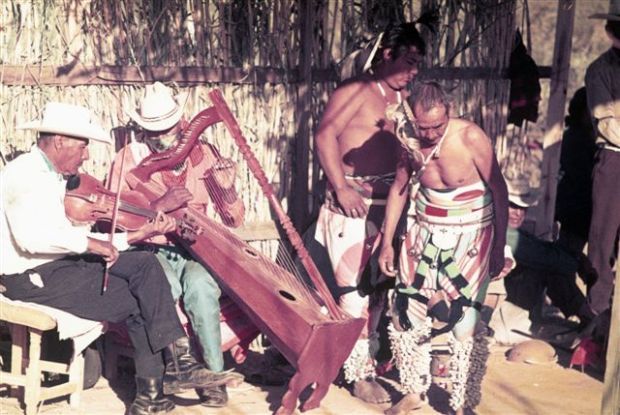Next Sunday is Palm Sunday — the beginning of Holy Week. For Yaquis, this means that the forty-day-long Passion Play they learned and adapted from Jesuit missionaries in the 1600s is moving toward its end. Every Friday evening in Lent, a religious procession has left the church in each of Tucson’s four participating communities, carrying sacred statues and singing religious songs. They circle the Way of the Cross, which is marked by a series of white crosses set up around the plaza in front of the church.
They are not alone. Each Friday they are joined by a growing number of costumed, masked individuals called Chapayekas, themselves members of a larger organization called Fariseos — Pharisees. These individuals are soldiers, armed with wooden swords and daggers, and they are searching for Jesus with the intent to kill Him. Over the weeks before Palm Sunday, these evil forces grow in number, power, and boldness.
This is indeed a sacred drama, but one in which the opposing forces are represented, not by individual actors speaking lines, but rather by marching and counter-marching groups of dedicated people. And on Palm Sunday, the day of Jesus’ triumphal entry into Jerusalem, they are all assembled and ready for the high drama of the next week.
I say “Palm Sunday,” but the Palm Sunday fiesta happens on Saturday night. It starts around sunset and lasts till shortly after dawn. The masked Chapayekas will be present in full strength, as will the black-clad Fariseos and another group called the Soldiers of Rome.
Off to one side of the plaza is a ramada, under which two kinds of ceremonial dances take place. The step-dancing pascolas give comic speeches in Yaqui and dance to music of violin and harp and also a flute and drum played by a single man. The solo deer dancer performs to songs sung by four men who accompany themselves on rasps and a water drum. He remains aloof and detached, wrapped in the power of his enchanted world.
Elsewhere in the plaza, the Matachinis dance. They are a group of men and boys dedicated to the Virgin of Guadalupe, who perform an energetic contradance. They, too, will dance on and off all night, sometimes ending up with a maypole.
The remarkable thing is the fact that we are welcome to attend this evening of great beauty. Of course, there are rules we must follow as guests: no alcohol or guns, of course, and no cameras of any sort, or recorders, or notebooks. Dress and behave respectfully, as you would at any religious ceremony.
Tucson’s four Yaqui communities are as follows: Pascua Pueblo, south of Valencia and west of Camino del Oeste; Old Pascua, south of Grant and east of Fairview, San Martín de Porres, near South 12th and 39th Street, and El Señor de los Milagros, behind Pueblo High School. Each village has different masks, dancers, and musicians. Some people like to go from one to another, taking it all in. And there is so much to see and hear.
The Yaqui Easter Ceremony is complex and beautiful. I strongly recommend Muriel Thayer Painter’s forty-page booklet A Yaqui Easter (Tucson: The University of Arizona Press.)





